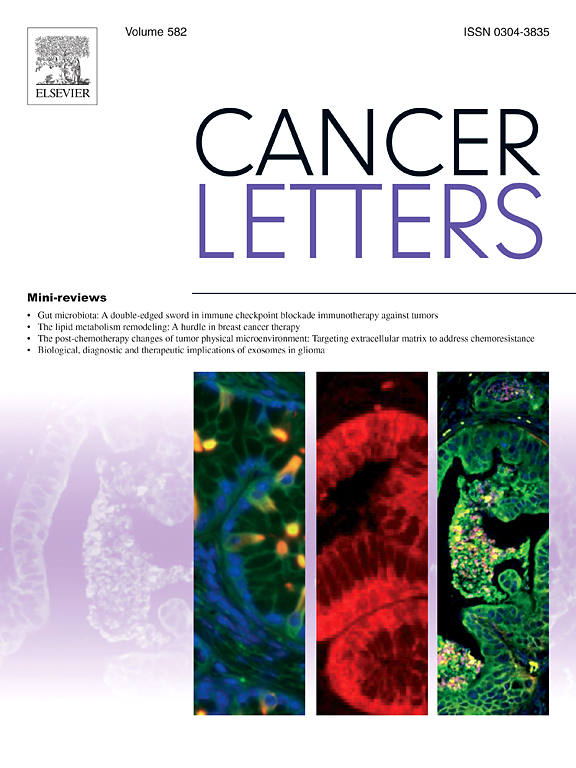胰腺导管内乳头状黏液瘤的囊肿液蛋白分层恶性风险
IF 9.1
1区 医学
Q1 ONCOLOGY
引用次数: 0
摘要
导管内乳头状粘液瘤(IPMN)是最常见的胰腺囊肿类型,通常在无症状患者中偶然发现。目前的共识指南主要基于影像学特征,在区分良性和恶性IPMNs方面具有高灵敏度但低特异性,导致不必要的手术。因此,发现生物标志物有必要改善IPMN的术前风险分层。从病理证实的低级别IPMN (n = 73)或高级别/侵袭性IPMN (n = 18)患者中获取胰腺囊肿液样本。采用液相色谱-串联质谱法进行全局蛋白质组定量。采用Wilcoxon秩和检验分析两组间差异表达蛋白(DEPs)。通过比较低级别IPMN和高级别/侵袭性IPMN,发现152个dep上调,74个dep下调(p <;0.05)。这些DEPs上游富集的调节因子包括let-7、miR-122、IL15和FLT1 (p = 6.76 × 10−5 - 5.97 × 10−3)。鉴定出5个LASSO系数最大且auc均为0.75的歧视性生物标志物(FAHD2A、TCEAL3、TWF1、MMUT和NTPCR)。组合五蛋白模型的自引导校正AUC为0.94。TCGA和GTEx数据库的联合分析显示,胰腺癌中TWF1过表达(p = 2.22 × 10−16)与预后不良相关(p = 0.0063)。本研究确定了几种囊肿液蛋白(特别是TWF1),可预测恶性胰腺囊肿病变。如果在其他患者群体中得到验证,这些生物标志物可能会提高高危IPMN术前检测的准确性,从而改善患者的预后。本文章由计算机程序翻译,如有差异,请以英文原文为准。
Cyst fluid proteins stratify malignant risk of intraductal papillary mucinous neoplasm of the pancreas
Intraductal papillary mucinous neoplasm (IPMN) is the most common type of pancreatic cyst often incidentally detected in asymptomatic patients. The current consensus guidelines, largely based on imaging features, have high sensitivity but low specificity in differentiating benign from malignant IPMNs, leading to unnecessary surgeries. Discovering biomarkers is thus warranted to improve the preoperative risk stratification of IPMN. Pancreatic cyst fluid samples were obtained from patients with pathologically confirmed low-grade (n = 73) or high-grade/invasive (n = 18) IPMN. Global proteome quantitation was performed using liquid chromatography-tandem mass spectrometry. Differentially expressed proteins (DEPs) between the two groups were analyzed using Wilcoxon rank-sum test. 152 upregulated and 74 downregulated DEPs were discovered by comparing low-grade IPMN with high-grade/invasive IPMN (all p < 0.05). The enriched upstream regulators of these DEPs included let-7, miR-122, IL15, and FLT1 (p = 6.76 × 10−5 - 5.97 × 10−3). Five discriminatory biomarkers with the largest LASSO coefficients and each with AUCs of >0.75 (FAHD2A, TCEAL3, TWF1, MMUT, and NTPCR) were identified. The combined five-protein model achieved a bootstrap-corrected AUC of 0.94. A combined analysis of TCGA and GTEx databases showed TWF1 overexpression in pancreatic cancer (p = 2.22 × 10−16) that was associated with poor prognosis (p = 0.0063). The present study identified several cyst fluid proteins (particularly TWF1) that are predictive of malignant pancreatic cyst lesions. If validated in other patient populations, these biomarkers may enhance the accuracy of the preoperative detection of high-risk IPMN and thereby improve patient outcomes.
求助全文
通过发布文献求助,成功后即可免费获取论文全文。
去求助
来源期刊

Cancer letters
医学-肿瘤学
CiteScore
17.70
自引率
2.10%
发文量
427
审稿时长
15 days
期刊介绍:
Cancer Letters is a reputable international journal that serves as a platform for significant and original contributions in cancer research. The journal welcomes both full-length articles and Mini Reviews in the wide-ranging field of basic and translational oncology. Furthermore, it frequently presents Special Issues that shed light on current and topical areas in cancer research.
Cancer Letters is highly interested in various fundamental aspects that can cater to a diverse readership. These areas include the molecular genetics and cell biology of cancer, radiation biology, molecular pathology, hormones and cancer, viral oncology, metastasis, and chemoprevention. The journal actively focuses on experimental therapeutics, particularly the advancement of targeted therapies for personalized cancer medicine, such as metronomic chemotherapy.
By publishing groundbreaking research and promoting advancements in cancer treatments, Cancer Letters aims to actively contribute to the fight against cancer and the improvement of patient outcomes.
 求助内容:
求助内容: 应助结果提醒方式:
应助结果提醒方式:


